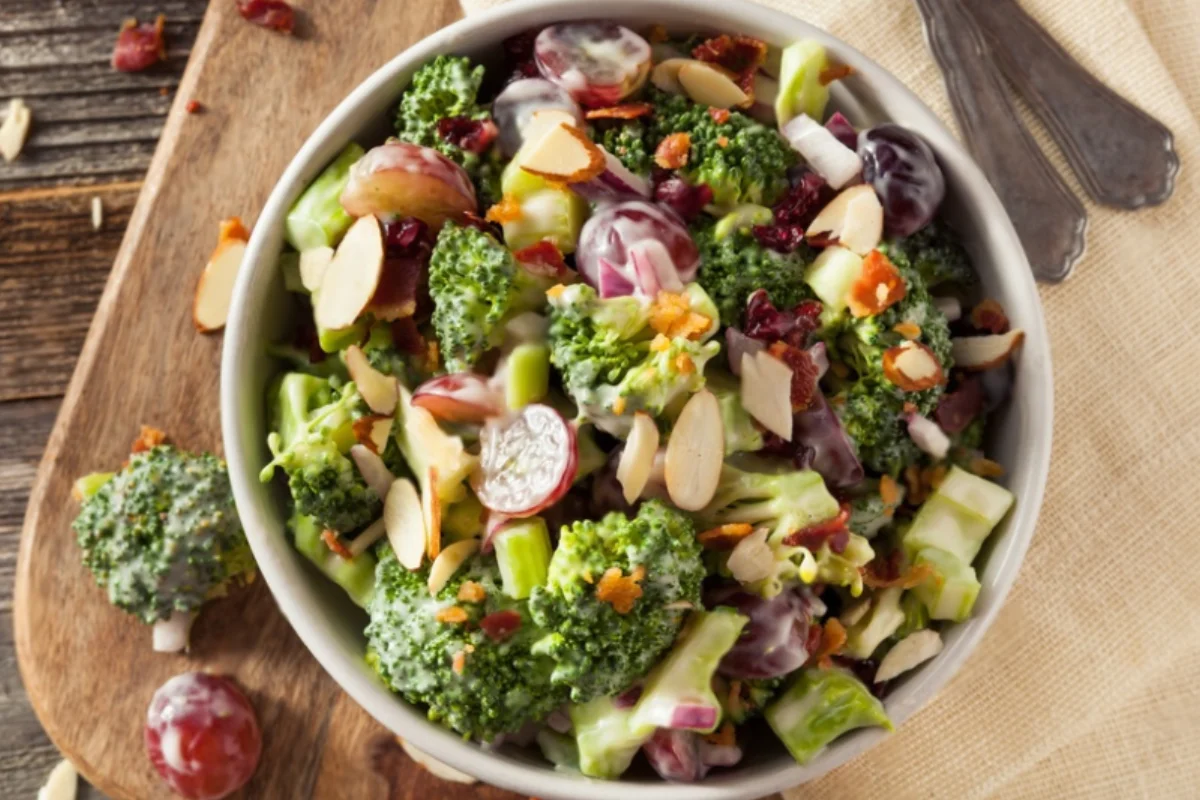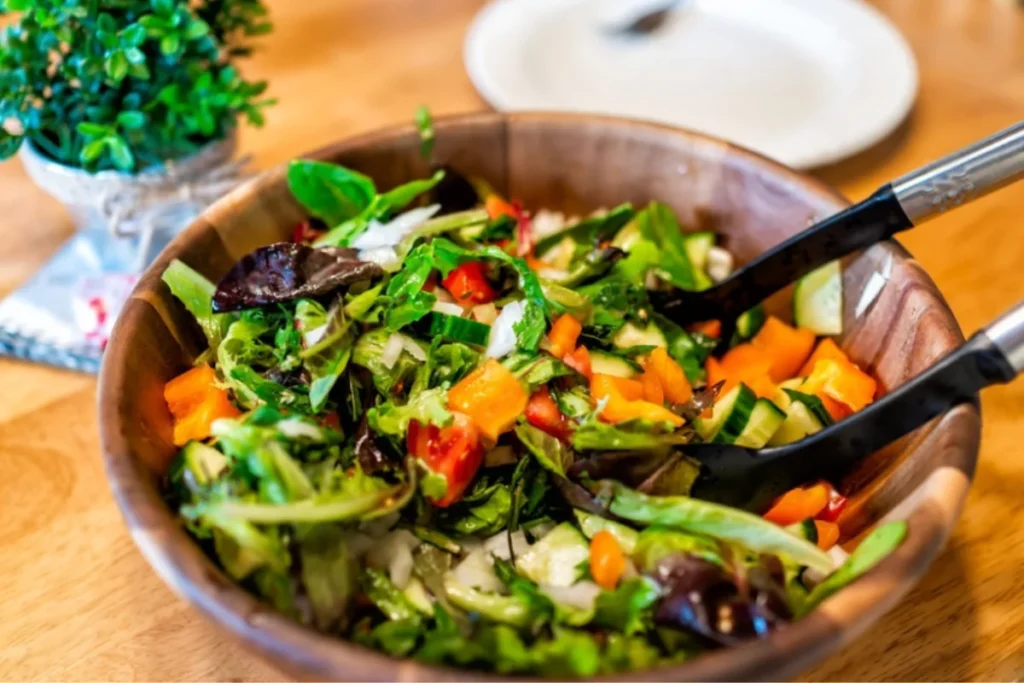Chopped salad, a culinary delight that has taken the world by storm, is more than just a dish; it’s a versatile and vibrant expression of freshness and flavor. At its core, a chopped salad is exactly what it sounds like: a salad whose ingredients have been cut into uniform sizes, typically around 1/2″ cubes. This method not only enhances the salad’s aesthetic appeal but also ensures that each bite is a perfect blend of all the ingredients.
- The key to a great chopped salad lies in its ingredients—from the crispness of romaine lettuce to the creaminess of avocado and the tanginess of vinaigrette dressings.
- It’s a celebration of textures and flavors, coming together in a harmonious mix that can be tailored to any palate or dietary need.
Chopped salads shine as both a side dish and a main course, offering a lighter meal option that doesn’t skimp on satisfaction. The ease of eating—no need to navigate around large leaves or chunks—makes it a favorite for dinner parties and quick lunches alike. For those looking to dive deeper into the art of salad making, exploring various dressing recipes can elevate a simple chopped salad into a gourmet experience.
Moreover, the nutritional aspect of chopped salads cannot be overlooked. Packed with vitamins, minerals, and fiber, they are a cornerstone for anyone aiming to maintain a healthy lifestyle. Understanding the health benefits of fresh salads is crucial for appreciating not just their taste, but also the positive impact they have on our well-being. For more on making salads that delight, explore our easy chicken salad chick broccoli salad recipe, a testament to simplicity and taste.
In essence, chopped salads are a testament to the beauty of simplicity in cooking. They remind us that with just a few quality ingredients and a bit of creativity, we can create meals that are as nutritious as they are delicious.
Understanding Chopped Salad Ingredients
Core Ingredients
The foundation of any chopped salad lies in its core ingredients, each selected for their unique textures and flavors that, when combined, create a dish full of variety and taste. Here are the essentials:
- Romaine lettuce hearts are the classic choice, providing a crisp base with a refreshing crunch.
- Cucumbers add a juicy, hydrating element, perfect for balancing richer components.
- Bright and colorful, bell peppers introduce a sweet and slightly tangy flavor.
- Chickpeas offer a hearty, protein-packed addition, making the salad more filling.
- Olives, particularly the kalamata variety, contribute a briny depth that complements the freshness of the other ingredients.
Each of these ingredients plays a pivotal role in constructing the perfect chopped salad. The romaine lettuce hearts, with their sturdy ribs, ensure the salad maintains its structure, preventing it from becoming a dense, leafy mass. Cucumbers and bell peppers not only add a splash of color but also various textures, from the cucumber’s crispness to the bell pepper’s slight crunch. Chickpeas, a versatile and nutritious legume, bring a satisfying chewiness and protein boost, while olives round out the flavor profile with their distinctive saltiness. Together, these core ingredients lay the groundwork for a truly memorable chopped salad experience.
Optional Additions for Flavor and Texture
To elevate a chopped salad from good to unforgettable, incorporating optional additions can introduce an array of flavors and textures. These ingredients allow for customization and creativity:
- Fresh herbs, like mint or parsley, infuse the salad with aromatic freshness.
- Various cheese varieties, such as feta or goat cheese, add creaminess and a tangy kick.
- Nuts and seeds provide a crunchy contrast, enhancing the salad’s texture.
Incorporating fresh herbs not only adds a burst of flavor but also brings a vibrant color to the dish. Cheese varieties, with their rich textures and diverse flavors, offer a creamy counterpoint to the crisp vegetables. Meanwhile, nuts and seeds introduce an enjoyable crunch, making every bite interesting.
These additions are not just about taste; they also contribute to the nutritional value of the salad, adding proteins, healthy fats, and essential vitamins. By carefully selecting these optional ingredients, one can tailor the chopped salad to suit any preference or dietary requirement, making it a versatile option for any meal.
Dressing Choices
Choosing the right dressing is crucial for bringing together the flavors of a chopped salad. Here are some popular options:
- A lemon-mustard vinaigrette offers a tangy and slightly spicy kick.
- Balsamic vinaigrette adds a sweet and tart richness.
- Ranch dressing provides a creamy texture with a hint of herbs.
Each dressing choice enhances the salad in unique ways. Lemon-mustard vinaigrette, with its zesty and sharp flavors, cuts through the richness of the ingredients. Balsamic vinaigrette contributes a complex sweetness that complements the freshness of the vegetables. Ranch dressing, beloved for its creamy consistency and herbaceous notes, rounds out the flavors, making the salad more indulgent. These dressings not only add moisture but also bind the ingredients, ensuring every bite is flavorful.
Dive into our ultimate guide to homemade Freddy’s fry sauce recipe variations for more inspiration on creating dressings that dazzle.
Preparation Tips and Techniques
Mastering the preparation of a chopped salad involves a few key tips and techniques to ensure every ingredient shines:
- Ensuring ingredients are absolutely dry, especially lettuce, is crucial for texture.
- Employing a sharp knife for uniform, clean cuts enhances the salad’s appearance.
- Cutting ingredients into similar sizes ensures even distribution and flavor in every bite.
Drying ingredients thoroughly prevents the salad from becoming soggy, maintaining the crispness of the vegetables. A sharp knife not only makes preparation safer but also preserves the integrity of each ingredient, preventing bruising. By cutting ingredients into uniform sizes, the salad becomes easier to eat and more visually appealing.
Additionally, consider preparing some ingredients ahead of time to streamline the assembly process. However, always add dressing right before serving to keep the salad fresh and vibrant. These preparation tips, when followed, elevate the simple act of making a chopped salad into an art form, ensuring a delightful eating experience.
Advanced Chopped Salad Concepts
Creative Variations
Exploring creative variations of chopped salad can transform this classic dish into a global culinary adventure. Here are some ideas:
- Incorporate quinoa or farro for a hearty, grain-based twist.
- Add grilled chicken or tofu to boost protein content.
- Mix in avocado and corn for a Southwestern flair.
Introducing quinoa or farro not only adds texture but also increases the salad’s nutritional value, making it a more satisfying meal. Grilled chicken or tofu can cater to both meat-lovers and vegetarians, providing a versatile protein option. Avocado and corn lend a creamy and sweet contrast, respectively, enhancing the overall taste profile. For those looking to explore more creative dishes, our hearty cowboy soup recipe offers a comforting one-pot meal that pairs wonderfully with a side of chopped salad.
These variations allow for endless customization, ensuring that the chopped salad remains a staple in diverse culinary traditions. By experimenting with different ingredients, one can easily adapt the salad to fit any theme, preference, or dietary requirement, keeping the dish fresh and exciting with every iteration.
Nutritional Information
Understanding the nutritional information of a chopped salad is key to appreciating its health benefits:
- Chopped salads are typically low in calories but high in essential nutrients.
- They provide a good source of dietary fiber, aiding in digestion.
- The variety of vegetables contributes vitamins and minerals, like Vitamin C and potassium.
Low in calories yet rich in nutrients, chopped salads are an excellent choice for those monitoring their calorie intake. The high fiber content not only helps in digestion but also promotes a feeling of fullness, aiding in weight management. Additionally, the inclusion of various vegetables ensures a wide range of vitamins and minerals, supporting overall health and well-being.
By choosing ingredients wisely, one can tailor the salad to specific dietary needs, making it a versatile and nutritious option for any meal.
Pairing with Meals
Pairing a chopped salad with meals can elevate any dining experience:
- Serve alongside grilled meats or fish for a balanced, nutritious meal.
- Complement pasta dishes with a light, refreshing salad.
- Pair with soup for a cozy, comforting meal option.
Grilled meats or fish and chopped salad create a harmonious balance of flavors and textures, offering a satisfying yet healthy meal. The freshness of the salad contrasts beautifully with the richness of pasta dishes, providing a palate-cleansing effect. When paired with soup, the salad adds a crunchy, fresh component, making the overall meal more diverse and enjoyable.
These pairings not only enhance the nutritional value of the meal but also ensure a variety of tastes and textures, catering to a wide range of dietary preferences and needs.
FAQs on Chopped Salad
What is the best way to chop vegetables for a salad?
The best method involves using a sharp knife and cutting vegetables into uniform sizes, ensuring each bite includes a bit of everything.
Can chopped salad be made ahead of time?
Yes, most ingredients can be chopped and stored in the refrigerator. However, add dressing right before serving to maintain freshness.
What are some vegan options for chopped salad?
Incorporate plant-based proteins like chickpeas, tofu, or quinoa, and use dairy-free cheese alternatives or omit cheese entirely.
How do you keep chopped salad fresh?
Keep the salad ingredients dry and refrigerated until ready to serve. Dress the salad just before eating to prevent sogginess.
Is chopped salad healthy?
Absolutely. Chopped salads are packed with fiber, vitamins, and minerals, making them a nutritious meal option.
Can I use frozen vegetables in a chopped salad?
It’s best to use fresh vegetables for texture and flavor, but thawed frozen peas or corn can be used in a pinch.
How long does chopped salad last in the fridge?
Undressed chopped salad can last 1-2 days in the fridge. Once dressed, it’s best eaten within a few hours.
What dressing is best for chopped salad?
Light vinaigrettes, like lemon-mustard or balsamic, complement chopped salads well without overpowering the fresh ingredients.
Can I add fruit to my chopped salad?
Yes, fruits like apples, pears, or berries can add a sweet contrast to the savory flavors of the salad.
How can I make my chopped salad more filling?
Add protein sources such as grilled chicken, tofu, or beans, and consider including hearty grains like farro or quinoa.
Conclusion
In conclusion, the versatility and nutritional value of chopped salads make them a stellar addition to any meal plan. By combining a variety of fresh vegetables, proteins, and optional additions like nuts, seeds, and cheeses, you can create a meal that is not only satisfying to the palate but also beneficial to your health. The key to a perfect chopped salad lies in the balance of flavors and textures, achieved through careful selection of ingredients and dressings that complement each other.
Whether you’re looking for a light side dish or a hearty main course, the chopped salad offers endless possibilities for customization, ensuring that you can cater to any dietary preference or restriction. Remember to keep your ingredients fresh, your vegetables chopped uniformly, and your dressings flavorful but not overpowering.
By incorporating the tips and techniques discussed, you can elevate your chopped salad from a simple dish to a culinary delight. So, embrace the creativity that chopped salads allow and enjoy the journey of discovering your favorite combinations. Not only will you be treating yourself to delicious meals, but you’ll also be nourishing your body with the essential nutrients it needs to thrive.


